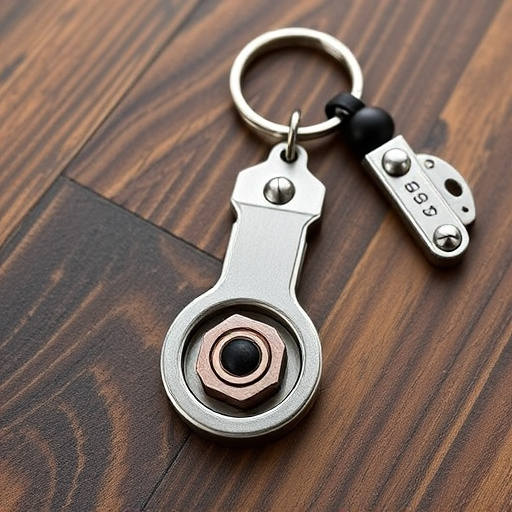Non-lethal keychain weapons, legal and easy to use, offer personal security on-the-go. With quick release mechanisms, they provide swift protection in emergencies. Allowed in many public spaces, their compact size and accessibility make them an attractive option for self-defense, especially for women. Responsible carrying requires understanding local laws, regular practice, and discreet use.
In today’s world, personal safety is paramount. One innovative solution gaining traction are keychain safety devices equipped with quick release mechanisms, offering a discrete yet potent means of self-defense. This comprehensive guide explores non-lethal keychain weapons allowed by law, delving into their mechanics, benefits, and responsible use. Understanding these compact tools empowers individuals to protect themselves confidently while navigating urban landscapes.
- Understanding Keychain Safety Devices
- Non-Lethal Weapons: Legal Considerations
- Quick Release Mechanism Explained
- Benefits of Using Keychain Self-Defense Tools
- Best Practices for Safe Carrying and Use
Understanding Keychain Safety Devices
Keychain safety devices equipped with quick release mechanisms offer an innovative solution for personal security while on-the-go. These compact and non-lethal keychain weapons are designed to provide individuals with a sense of protection without causing harm. In many regions, carrying non-lethal self-defense tools is legal and allowed, making them an appealing option for those seeking peace of mind in potentially dangerous situations.
Understanding the quick release mechanism is crucial to utilizing these devices effectively. The design allows users to swiftly deploy the tool when needed, ensuring a swift response during emergencies or unexpected encounters. This simplicity and ease of use make it an attractive feature, especially for individuals who prioritize preparedness without compromising their safety.
Non-Lethal Weapons: Legal Considerations
In many jurisdictions, non-lethal weapons, including keychain safety devices with quick release mechanisms, are subject to specific legal considerations and regulations. While self-defense is a fundamental right, the use of force must be proportional and reasonable. Non-lethal keychain weapons allowed on public spaces vary by region, with some areas permitting them for personal protection while others restrict their use due to potential misuse or public safety concerns.
Understanding the local laws regarding non-lethal keychain weapons is essential for responsible ownership. Users should familiarize themselves with the specific regulations, including age restrictions, permit requirements, and prohibited locations. Compliance with these legal considerations ensures that individuals can protect themselves effectively while avoiding unnecessary legal repercussions.
Quick Release Mechanism Explained
The quick release mechanism on a keychain safety device is a key feature that distinguishes it from traditional keychains. Unlike standard keychains that require manual manipulation to open, this innovative design offers a swift and effortless way to access your keys in emergencies. It’s a simple yet powerful concept—a flip, a twist, or a gentle press, and the keychain springs apart, allowing easy retrieval of your keys, wallet, or other essential items.
This mechanism is particularly useful for those who carry non-lethal keychain weapons for personal safety. With just a quick motion, users can separate the device from their bag or pocket, ensuring they’re prepared to defend themselves if needed. The ease of use promotes peace of mind, knowing that help is readily available with a simple release.
Benefits of Using Keychain Self-Defense Tools
Carrying a keychain self-defense tool is an increasingly popular choice for personal safety, especially for women and individuals who prefer non-lethal options. These compact devices offer a range of benefits in potentially dangerous situations. Firstly, they are easily accessible; always attached to your keys, you can quickly retrieve the tool when needed. This immediate availability can be crucial in high-stress scenarios.
Moreover, keychain self-defense tools provide a sense of empowerment and peace of mind. Knowing that you have a means of protection on hand allows individuals to feel more secure while walking alone or in unfamiliar places. With various designs featuring simple quick-release mechanisms, these devices enable users to defend themselves effectively without the need for extensive training or physical strength—a significant advantage over traditional weapons that require permits and specific legal guidelines, such as non-lethal keychain weapons allowed by law enforcement agencies.
Best Practices for Safe Carrying and Use
When carrying a keychain safety device with a quick release mechanism, adhering to best practices ensures its effectiveness and safety in unexpected situations. Always keep your device accessible yet secure; store it in a visible yet discreet location, like an outer jacket pocket or a dedicated carry case. Regularly practice the deployment and retraction of the mechanism to ensure smooth, reliable operation under stress.
Remember that while these devices are designed for self-defense, they are typically non-lethal weapons allowed in public spaces. Familiarize yourself with local laws and regulations regarding their use and carrying. Be mindful of your surroundings; avoid drawing attention to your keychain unless faced with an imminent threat. Proper training and understanding the limitations of your device are crucial to responsible and safe carrying.
Keychain safety devices equipped with quick release mechanisms offer a convenient and effective self-defense option, providing users with peace of mind in potentially dangerous situations. With proper understanding, legal considerations, and best practices in place, these non-lethal weapons can be a viable solution for personal protection. Remember, knowing your local laws regarding non-lethal keychain weapons allowed is essential before carrying such a device, ensuring you stay within legal boundaries while enjoying enhanced security.
